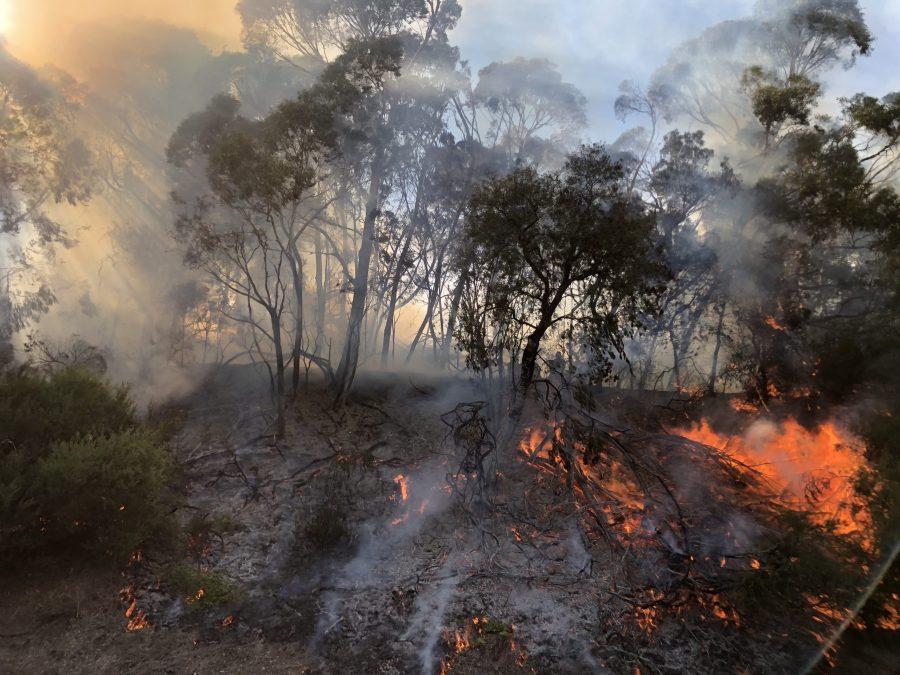With the sweat dripping from his brow and woodsmoke in his lungs, Chris Lobdell briskly cuts and clears trees with a chainsaw in an attempt to create a fire break to stem a wildfire just a few miles away. It’s up to him and his crew to protect the forest from the raging inferno, one that shouldn’t be happening this early in the season.
Unfortunately, wildfires across the world are increasing in size, frequency and destruction. A study done by the Journal of Geophysical Research found that western states are expected to experience a 78% increase in area burned before 2050, and it’s only going to get worse from there.
So where did wildfire seasons come from? AP Environmental Science teacher Nicole Loomis said a combination of factors contribute to it.
“There are multiple things causing them,” Loomis said. “It’s people; it’s power lines. It’s climate change, drought, heat, and it’s forest management practices over time.”
As a result of climate change, Loomis said heat domes, high-pressure systems that trap hot air, are some of the main culprits. They cause increased temperatures and droughts and are becoming far more frequent.
“The heat domes that are hitting the Northwest are unprecedented,” Loomis said. “These are like once-in-a-thousand year heat events that they’re having two of in one summer. And those thousand-year events are now going to become 100 or 50 or 20-year events rather than things that you would almost never see.”
Unnatural shifts in what would usually be natural events are creating ideal environments for wildfires to spread, but human activity is often the spark that causes forests to go up in flames. Loomis said because it’s becoming more expensive to live in cities, there’s been a trend of people moving into remote areas where people didn’t live previously, and as a result, infrastructure has to be built.
“There’s a lot of ways fires can get started,” Loomis said. “Sometimes your power lines spark, and if your area is dry, then things will catch on fire. It would’ve been a lot smarter to put the power lines underground rather than having power lines above the ground and not necessarily keeping them maintained.”
Alongside the impacts of infrastructure, practices regarding forest management have caused a buildup of fuel on forest floors. This excess of dead trees and branches is another element causing wildfires to be so devastating. Loomis said this is also a result of climate change.
“Bark beetles and pine borer beetles have come through and really killed a lot of trees, and so those trees are dead and just ready to burn,” Loomis said. “They’re coming into new areas because of climate change because they’re not getting a hard freeze in the winter anymore.”
Lobdell, who worked in a crew fighting forest fires throughout this past summer, said he was mostly responsible for protecting unburned areas from fires rather than suppressing them directly.
“We cleared 30 foot wide sections of forest for a few miles surrounding parts of land we wanted to protect,” Lobdell said. “We were basically drawing a line in the sand where you are trying to prevent the fire from crossing.”
This practice, known as creating fire breaks, is meant to create a large enough gap between fuel sources that a fire can’t spread to certain areas of land.
The greatest effect that Palo Altans feel from the fires is smoke. A high Air Quality Index is now commonplace in the late summer and fall months, and for junior Kyle Park, a runner with exercise-induced asthma, fire seasons can be especially difficult.
“During bad conditions like wildfire season, (asthma) gets much, much worse,” Park said. “I can only do easy runs, and I still feel awful.”
In response to what is expected to be a difficult smoke season, PAUSD released protocols regarding high AQI levels. If the index registers at 151 or higher, then COVID-19 protocols will be temporarily suspended and outdoor activities like lunch and PE will be moved indoors. Rachel Gibson, chair of the district’s sustainable schools committee, has some issues with the protocol.
“Pollution from woodfire smoke increases our susceptibility to respiratory infections including COVID-19,” Gibson said at a school board meeting. “A number of parents are concerned about certain activities taking place indoors.”

